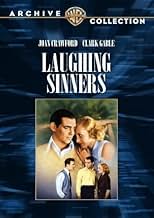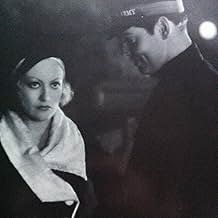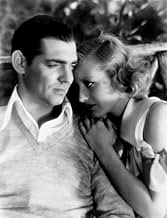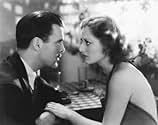Agrega una trama en tu idiomaA Salvation Army worker recruits a suicidal cafe dancer.A Salvation Army worker recruits a suicidal cafe dancer.A Salvation Army worker recruits a suicidal cafe dancer.
- Dirección
- Guionistas
- Elenco
- Premios
- 1 premio ganado en total
Henry Armetta
- Tony
- (sin créditos)
Jack Baxley
- Waiter
- (sin créditos)
Clara Blandick
- Salvation Army Woman
- (sin créditos)
Sherry Hall
- Poker-Playing Salesman
- (sin créditos)
Tenen Holtz
- Poker-Playing Salesman
- (sin créditos)
Mary Ann Jackson
- Betty
- (sin créditos)
Karen Morley
- Estelle Seldon (photo in newspaper)
- (sin créditos)
- Dirección
- Guionistas
- Todo el elenco y el equipo
- Producción, taquilla y más en IMDbPro
Opiniones destacadas
A lot of interesting bits in this. O'Henry bars in 1931?! Reference to the Fresh Air taxi? Acting very good throughout, especially Neil Hamilton who was a real sleazeball. Joan Crawford, who I was never a big fan of, was very pretty, certainly better thas in "This Modern Age" (same year) and almost to her Lucille La Seur standards. The 2nd half was better than the 1st, but they, as was common then, always ended the movie too abruptly. Most revealing was the scene early on in which a bunch of kids were playing in the park, boys & girls. Some were black some were white. Then the religious right and their Code came along after which blacks were only portrayed as servants, buffoons and dullards.
This may not be the greatest of the Crawford/Gable pairings, but their affinity for each other is obvious, and as always what is unsaid between them speaks volumes about their off-screen relationship. The film's other highlights include Joan's singularly eccentric "farmer" dance, for which she sports a false nose and beard! This was surely the inspiration for the Soggy Bottom Boys' "disguises" and dancing in the climax of 'O Brother Where Art Thou?'. In any event, the phenomenal originality of her performance provides another dimension to Crawford's enduring film legacy.
Oh, boy. Clark Gable in the Salvation Army. Where did they come up with this stuff? Nightclub performer Ivy Stevens (Joan Crawford) is despondent upon learning Howard "Howdy" Palmer (Neil Hamilton) has no intention of marrying her. She was just a booty call to our boy Howdy. How Neil Hamilton got so many roles in the early '30s as a ladies man type is beyond me but that's how it was then I guess. Anyway, Ivy decides to jump off a bridge but she is stopped by kindly and handsome Salvation Army worker Carl (a mustacheless Clark Gable). Ivy joins up with the Salvation Army too and is seemingly happy with her new lifestyle. But then one day Howdy spots her and, despite being married now, makes a move for her. Can Ivy resist Howdy's seductive ways? Can any woman?
There's a few things wrong with this movie. First, on no planet does Joan freaking Crawford, at this time a young and sexy dancer, get that upset over being dumped by Neil Hamilton. He was born looking like a banker. So that's unbelievable. Second and third things are that Clark Gable is no Salvation Army worker and he sure as hell isn't a guy named Carl! Joan's farmer dance is the highlight of the movie and probably her best dancing number from all of her early dancing movies. Overall it's a watchable but mostly forgettable melodrama about a "wrong" woman going right. Avid Crawford and Gable fans will like it most.
There's a few things wrong with this movie. First, on no planet does Joan freaking Crawford, at this time a young and sexy dancer, get that upset over being dumped by Neil Hamilton. He was born looking like a banker. So that's unbelievable. Second and third things are that Clark Gable is no Salvation Army worker and he sure as hell isn't a guy named Carl! Joan's farmer dance is the highlight of the movie and probably her best dancing number from all of her early dancing movies. Overall it's a watchable but mostly forgettable melodrama about a "wrong" woman going right. Avid Crawford and Gable fans will like it most.
Joan Crawford is a café dancer whose long term, long distance affair with traveling salesman Neil Hamilton comes crashing to a finish when he dumps her by leaving her a goodbye note written on the back of a menu. Despondent, she sets out to jump into the river, only to be stopped and saved (in more than one sense) by mustache-less Salvation Army officer Clark Gable. Next thing you know, Joan is sporting an Army uniform herself and singing hymns
.but sooner or later, Hamilton is bound to show up again. And what then?
The plot isn't much, but Crawford's performance is excellent as her character veers wildly from joyous flapper to reformed sinner. The scene where she reads Hamilton's note is stunningly sad. Gable never looks quite natural but does seem to contain a reservoir of strength and energy that lurks just beneath the surface of his peaceful character. –At least that's my view from this time and place; hard to imagine what effect his performance would have had on a 1931 audience just becoming familiar with that face, that screen presence.
The highlight of the film is almost certainly Joan's dance in an opening scene—donning a fake nose and beard and a farmer outfit, she humorously bounces around for a couple of minutes before shedding the costume and really cutting loose, to her audience's delight and her own obvious joy. It has to be said that Joan as flapper is quite a bit more exciting than Joan as saved woman.
Hamilton is superb in a thoroughly despicable role. Roscoe Karns and Guy Kibbee are fellow salesman and together they certainly portray the kind of sleazy crew who inspire good people to lock up their daughters.
Overall—no surprises but Crawford is certainly worth watching, especially the opening and closing minutes.
The plot isn't much, but Crawford's performance is excellent as her character veers wildly from joyous flapper to reformed sinner. The scene where she reads Hamilton's note is stunningly sad. Gable never looks quite natural but does seem to contain a reservoir of strength and energy that lurks just beneath the surface of his peaceful character. –At least that's my view from this time and place; hard to imagine what effect his performance would have had on a 1931 audience just becoming familiar with that face, that screen presence.
The highlight of the film is almost certainly Joan's dance in an opening scene—donning a fake nose and beard and a farmer outfit, she humorously bounces around for a couple of minutes before shedding the costume and really cutting loose, to her audience's delight and her own obvious joy. It has to be said that Joan as flapper is quite a bit more exciting than Joan as saved woman.
Hamilton is superb in a thoroughly despicable role. Roscoe Karns and Guy Kibbee are fellow salesman and together they certainly portray the kind of sleazy crew who inspire good people to lock up their daughters.
Overall—no surprises but Crawford is certainly worth watching, especially the opening and closing minutes.
The second film that had Clark Gable and Joan Crawford together didn't start out that way. Laughing Sinners started out with Johnny Mack Brown as the Salvation Army Worker who saves Crawford and the film was completed when Louis B. Mayer saw the film and said reshoot it with Gable. This was after having seen them together in Dance Fools Dance where Gable was a villain and had only a couple of scenes with Crawford. This is according to Joan herself in a tribute she wrote in the Citadel Film Series Book, The Films of Clark Gable.
Crawford is definitely in her element as singer/dancer and good time Prohibition party girl who falls for the charms of Neil Hamilton, a traveling salesman. You know what a bunch of party animals they are, just ask Arthur Miller. Anyway Hamilton decides though he thinks Joan's great in the hay, he wants to marry the boss's daughter and does, leaving her flat and despondent.
One night as she's ready to throw herself off a bridge, Salvation Army worker Clark Gable stops her. She likes him, but still has a yen for Hamilton and he, her.
Given Clark Gable's later image the casting of him as a Salvation Army worker is ludicrous. Mayer knew that and during the course of the film he gives him a nice prison background before he joined Edwin Booth's Army. The only way Gable could possibly fit the part. Anyway Mayer did it for the obvious chemistry between Gable and Crawford.
It's more Joan's picture than his though. Later on her talents as a dancer which brought her to film in the first place would be not seen at all. So Laughing Sinners is a treat in that way.
The film is based on a Broadway play Torch Song which ran for 87 performances the year before and starred Mayo Methot, Reed Brown, and Russell Hicks in the parts that Crawford, Hamilton, and Gable have. Coming over from the Broadway cast is Guy Kibbee in the role of another salesman, the only one to repeat his role from Broadway. Roscoe Karns and Cliff Edwards play another pair of salesmen and Marjorie Rambeau is Crawford's party girl friend.
Russell Hicks is definitely more my idea of a Salvation Army worker, but Gable's more my idea of a leading man opposite Joan Crawford.
Crawford is definitely in her element as singer/dancer and good time Prohibition party girl who falls for the charms of Neil Hamilton, a traveling salesman. You know what a bunch of party animals they are, just ask Arthur Miller. Anyway Hamilton decides though he thinks Joan's great in the hay, he wants to marry the boss's daughter and does, leaving her flat and despondent.
One night as she's ready to throw herself off a bridge, Salvation Army worker Clark Gable stops her. She likes him, but still has a yen for Hamilton and he, her.
Given Clark Gable's later image the casting of him as a Salvation Army worker is ludicrous. Mayer knew that and during the course of the film he gives him a nice prison background before he joined Edwin Booth's Army. The only way Gable could possibly fit the part. Anyway Mayer did it for the obvious chemistry between Gable and Crawford.
It's more Joan's picture than his though. Later on her talents as a dancer which brought her to film in the first place would be not seen at all. So Laughing Sinners is a treat in that way.
The film is based on a Broadway play Torch Song which ran for 87 performances the year before and starred Mayo Methot, Reed Brown, and Russell Hicks in the parts that Crawford, Hamilton, and Gable have. Coming over from the Broadway cast is Guy Kibbee in the role of another salesman, the only one to repeat his role from Broadway. Roscoe Karns and Cliff Edwards play another pair of salesmen and Marjorie Rambeau is Crawford's party girl friend.
Russell Hicks is definitely more my idea of a Salvation Army worker, but Gable's more my idea of a leading man opposite Joan Crawford.
¿Sabías que…?
- TriviaModern sources state that a preview of the film had such a bad reception that M-G-M production head Irving Thalberg decided to re-shoot part of the picture, dropping Johnny Mack Brown as Carl and re-shoot it with Clark Gable. At that point, Brown's career in mainstream feature films at MGM ended and he transitioned to 'B' westerns.
- ErroresOne year after Howard marries his wealthy boss's daughter he is still a traveling salesman, staying in cheap hotels. The only reason for him to do so is in order for him to meet Ivy again, but it is absurd that his socialite wife would want her husband doing such a job. He could have encountered Ivy in some other way.
- Citas
Man Boarding Train: [annoyed and impatiently waiting to get by a kissing Ivy and Howdy] Well, anytime you get through.
Ivy 'Bunny' Stevens: Mister, we never get through.
- ConexionesFeatured in Fast Workers (1933)
- Bandas sonoras(What Can I Do?) I Love That Man
(uncredited)
Music by Martin Broones
Lyrics by Arthur Freed
Sung by Joan Crawford at the cabaret
Selecciones populares
Inicia sesión para calificar y agrega a la lista de videos para obtener recomendaciones personalizadas
Detalles
- Fecha de lanzamiento
- País de origen
- Idiomas
- También se conoce como
- Complete Surrender
- Locaciones de filmación
- Productora
- Ver más créditos de la compañía en IMDbPro
Taquilla
- Presupuesto
- USD 338,000 (estimado)
- Tiempo de ejecución1 hora 12 minutos
- Color
Contribuir a esta página
Sugiere una edición o agrega el contenido que falta

Principales brechas de datos
By what name was Laughing Sinners (1931) officially released in India in English?
Responda



































